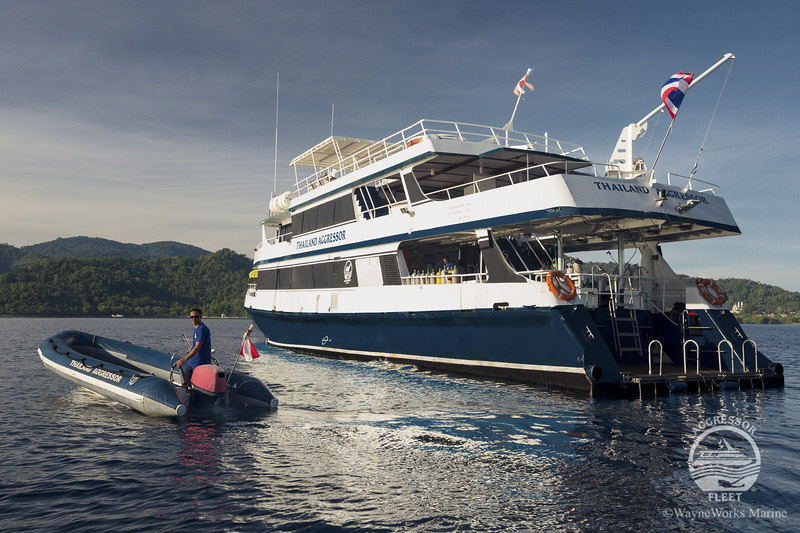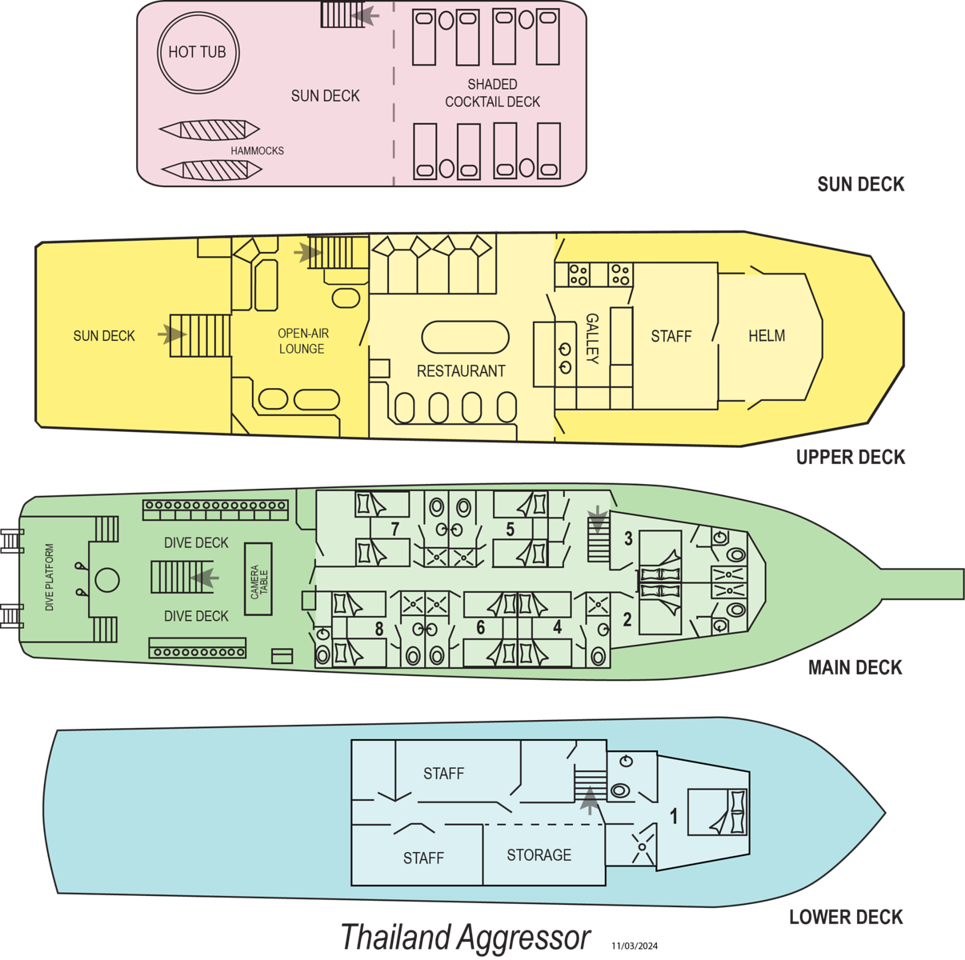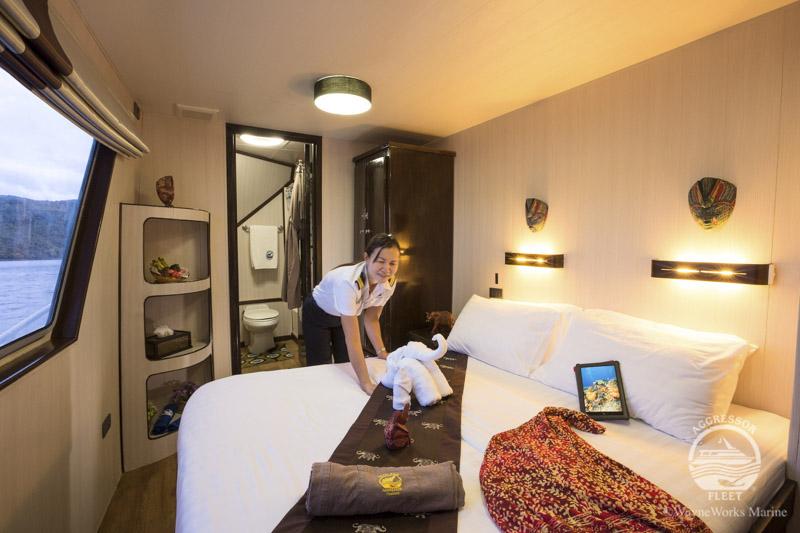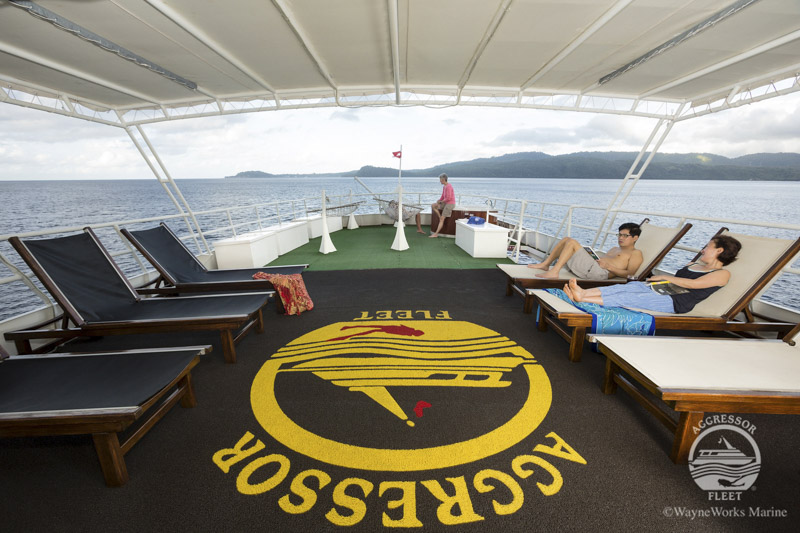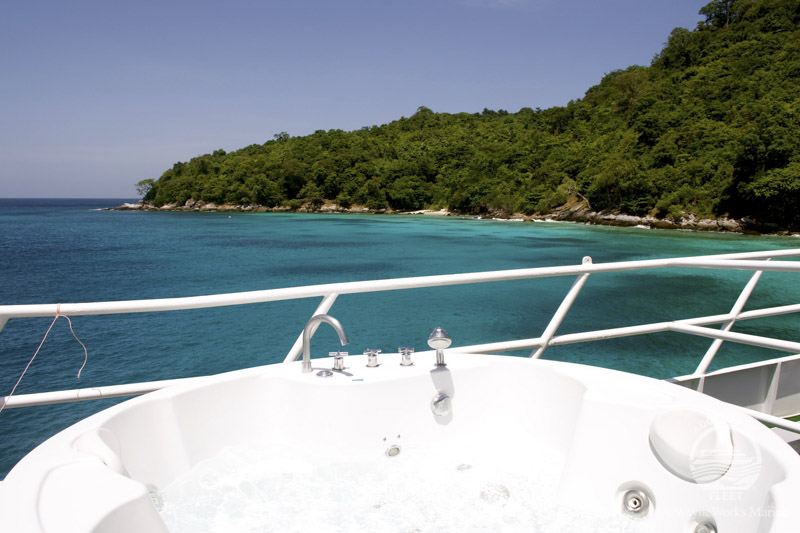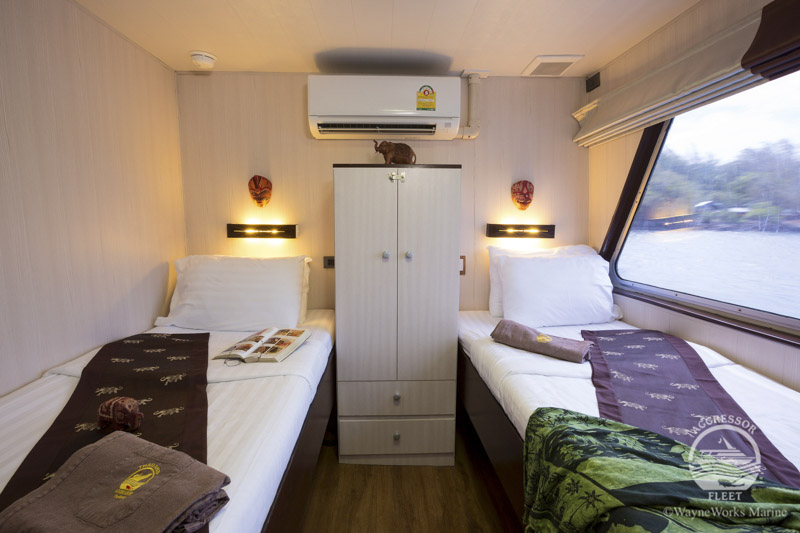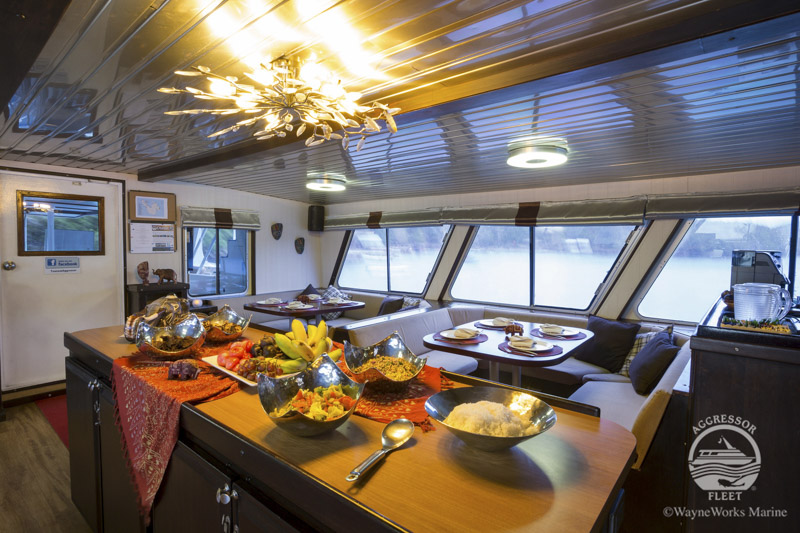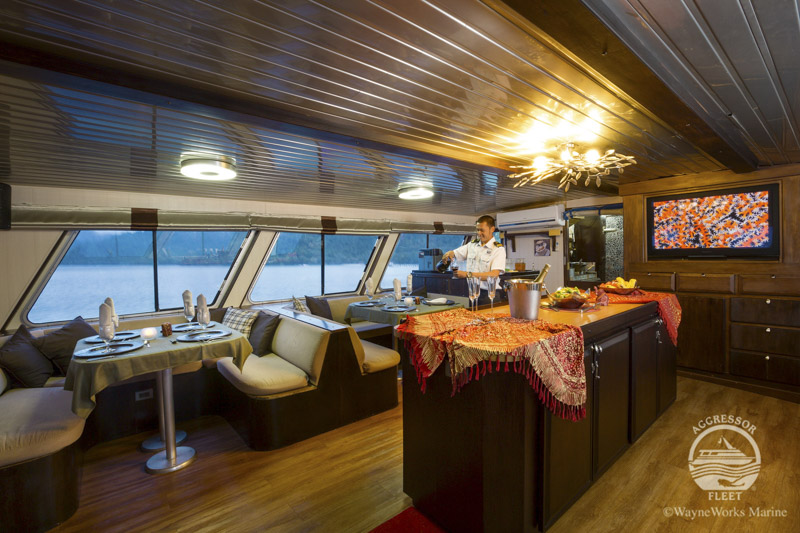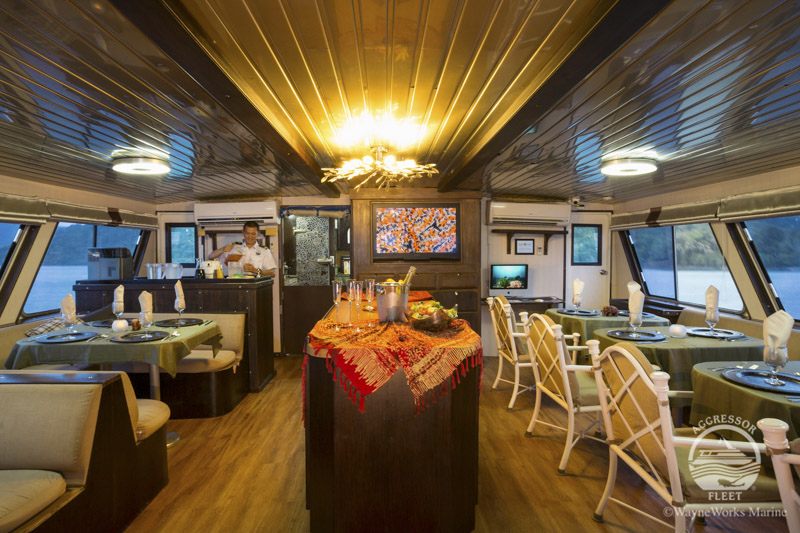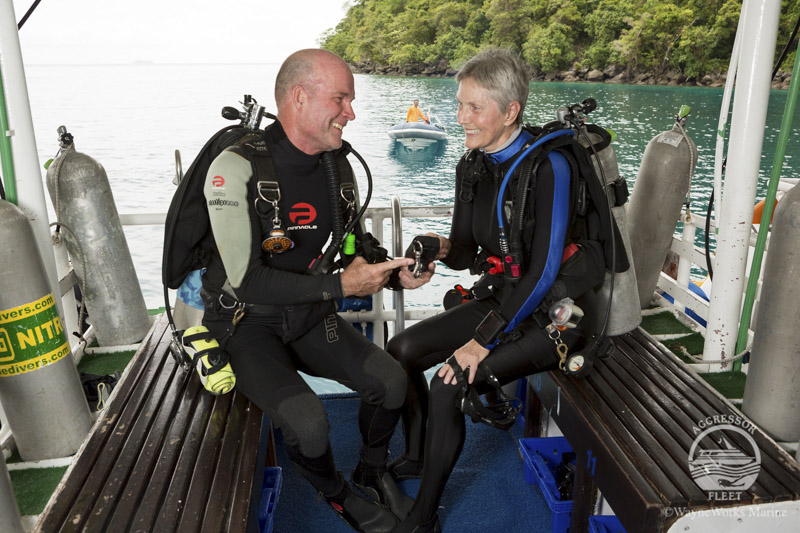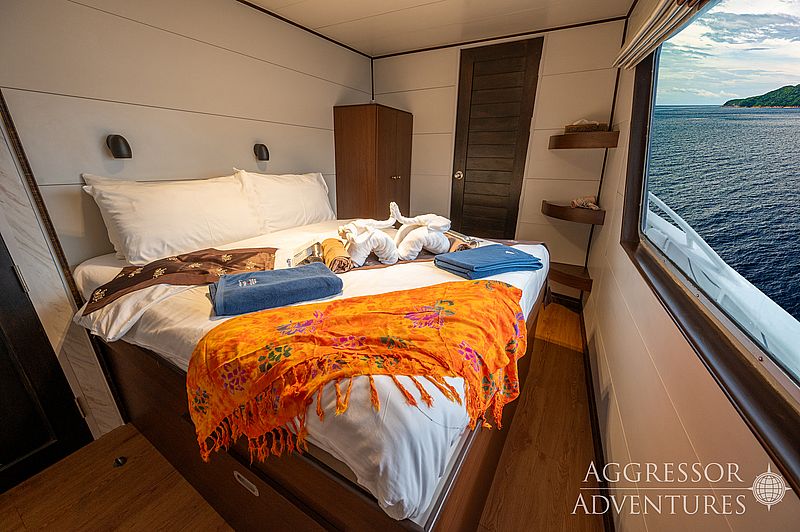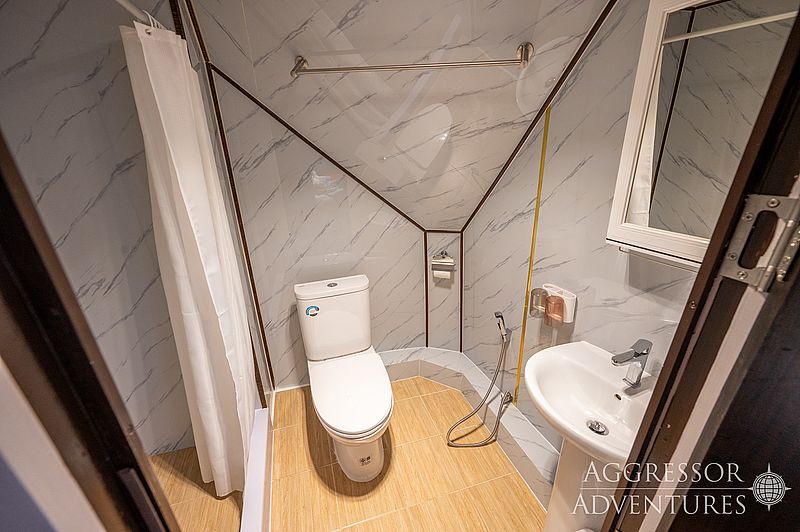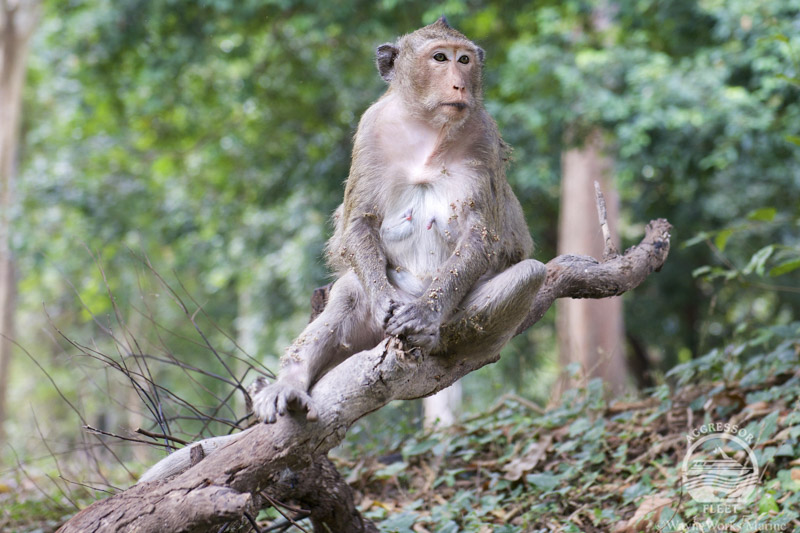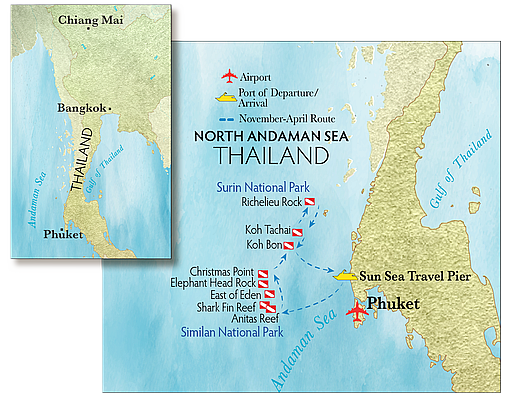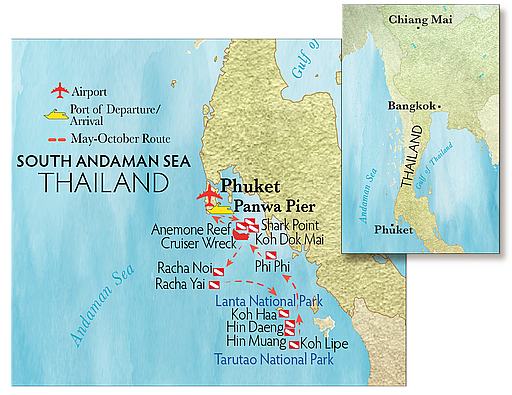Impressionen: Thailand Aggressor
Angaben zum Schiff
Technische Daten des Bootes
Kabinentypen & Details
Deluxe
Kabintyp Details
Bathroom
Master
Kabintyp Details
Bathroom
Routen und Details
North Andaman Sea
Mehr erfahren
Nearly all of the 9 islands are surrounded by huge underwater rock formations, eroded by the action of a relentless sea. These stone giants are home to an amazing variety of marine life, with depths often reaching 40 meters or more. Narrow swim-thru's, caverns and underwater canyons form a truly unique diving landscape. With names like 'Elephant Head', 'Boulder City', 'Sharkfin Reef' and 'East of Eden', you'll soon appreciate why the Similans deserve the reputation they've obtained.
Koh Bon and Koh Tachai: Are two uninhabited islands, situated between the Similans and Surin National Park to the North of the Similans. They offer a variety of excellent dive sites - including a breathtaking drop-off - with a wealth of hard and soft corals, and great opportunities to see passing manta rays and whale sharks.
Anita's Reef - Barracuda’s Point, “Hin Muan Deaw”
The Thai name for this spectacular rock is “Hin Muan Deaw” and is the best way to describe how beautiful this rock really is, as it directly translates to “Whole roll (of film) rock”, as one can use an entire roll film solely on this rock. The reef slope falls from the reef flat at 15 – 35 ft (5 – 10 m) to the sand bottom at a maximum of 85 – 90 ft (26 - 28 m).
West of Eden basically comprises giant granite boulders that create nice canyons, with walls covered with colorful soft corals and giant sea fans. Some areas are characterized by rubble and sand slope falling to a depth of 100 – 115ft (30 - 35 m).
Bon - Koh Bon West Ridge, Koh Talu: The wall, part of the Similan National Park, is decorated with various colorful soft corals and hard corals. From the ridge to the northeastern side are reefs that stretch along island. The reef slopes from a depth of 30 ft (10 m) down to a sandy bottom at 80 – 100 ft (25 - 30 m). The majority of corals here are hard corals, including staghorn coral and brain coral that are interspersed with a few big coral heads. To the northwest of the island, there is a submerged pinnacle. The pinnacle is at a depth of 60 – 150 ft (18 - 45 m) and is covered by an abundance of yellow soft corals and large sea fans.
Tachi Reef – Leopard Shark Reef: Tachai Reef stretches through the eastern side of the island, going from the northeast to the southwest. The reef slope falls from 16 – 33 ft (5 - 10 m) to the sand floor at 82 – 98 ft (25 - 30 m). Hard corals cover the entire area, most of which are staghorn corals, pore corals, brain corals, and fire corals. In the southern part, the gentle slope becomes a steep drop-off that continues from the island down to 98 ft (30 m). Divers regularly see leopard sharks lying at the outer sandy area and sometimes in shallow areas. Large stingrays are found on occasion too.
One of the most famous dive sites of Thailand, Richelieu Rock is an isolated pinnacle to the east of Surin Islands. Forming a horseshoe figure, the pinnacle fall steeply to the surrounding sand bottom at a maximum depth of 115 ft (35 m). The south side is a bay with a slope that gently falls to the deep, while the rest comprises sheer walls, groups of rock and numerous small caves that are home to various marine life. Due to the diversity of small and large creatures, Richelieu Rock is a paradise for underwater photographers. Ghost pipefish, frogfish, harlequin shrimp, seahorses, Janss pipefish are some of the smaller marine life that can be spotted here. Also, divers have often encountered cuttlefish mating. In addition, plenty of anemone fish species, particularly tomato clownfish, are regularly sighted.
South Andaman Sea
Mehr erfahren
Koh Haa No.3, a long island to the west of the lagoon. It is also another good dive spot, however, less famous than the two towers. This site is perfect for macro lovers.
KOH HAA – NEUA - The Chimney, Koh Haa No.1: Koh Haa – Neua is the northernmost island of Koh Haa group. Reefs surround this island with the north coast featuring a wall line covered with soft coral, sea fans and barrel sponges. A hard coral reef slope stretches from the southeast side to the east side of this island. The maximum depth at Koh Haa – Neua is 80 – 100 ft (25 – 30 m). The most popular diving spot on this island is located on the south side, and it is characterized by stunning outcrops covered by dense growths of south corals and sea fans that create a dazzling swim through. At 50 – 60 ft (16 – 18 m), there is a grotto that leads to a chimney-like vertical hole – another highlight of this dive site. This chimney has two exits at a depth of 15 ft (5 m).
KOH HAA – YAI - The Twin Cathedral: The biggest of the Haa islands is Koh Haa Yai. It is characterized by a steep cliff perpendicular to sea level that stretches all the way from above the water to depths of up to 100 ft (30 m). Koh Haa Yai is surrounded by reefs, and the most famous dive spot is the rock wall at the south side of the island, which ends in a sandy bottom at 80 – 100 ft (25-30 m) and is covered with a variety of soft corals, sea fans and hard corals.
Hin Daeng: If Richelieu Rock is the best dive site in the Northern Andaman area, then Hin Daeng and Hin Muang, the striking twin outcrops alone in the open sea, are undoubtedly the best of the Southern Andaman region. Meaning ‘red rock’ in Thai, Hin Daeng is covered with red soft corals, which makes the rock appear red. Only three small pinnacles are visible from the surface, but once underwater, the vast from of Hin Daeng stretches 100 – 130 ft (30-40 m) down before reaching the sandy bottom.
Hin Muang: The twin outcrops to the west of Hin Daeng are referred to as Hin Muang, which means, “purple rock” in Thai. The outcrops are totally submerged, and are covered with purple soft coral, hence the site name. The outcrops are long and narrow, reminiscent of loaves of French bread. There are several pinnacles, with drop-offs stretching down to the sandy bottom at 150 – 200 ft (45-60 m). The drop-offs around Hin Muang are rich with marine life and covered by soft corals, gorgonian sea fans and black corals.
Bida Nok: Boasting a remarkably dramatic underwater topography, Koh Bida Nok is characterized by steep precipices, caves, swim-throughs and underwater crags. It is no wonder that Koh Bida Nok and its sister island Koh Bida Nai are two of the most popular dive site in the Phi Phi islands. There is a small underwater bay at the southern side of the island made up of a reef slope and rocky floor that starts at 20 ft (6 m) and ends in a sandy bottom at 65 ft (20 m). A vertical swim-through at the southwest side of the island, beautifully illuminated by surface lights, is not to be missed.
Bida Nai: Like its sister island, Koh Bida Nai has an amazing topography of underwater crevices, huge boulders, and fields of staghorn reef. Stretched across the south and west coasts of the island is a gradual reef slope that starts at a depth of 15 – 30 ft (5-10 m) and is made up of hard corals like pore corals, table corals and staghorn corals. There are also some big boulders and a swim-through on the southern side.
The wreck is 280 ft (85 m) long by 82 ft (25 m) wide, with four decks with large passages, and window holes divers can use to gain easy access to explore the specious interior. However, some past of the wreck has noticeably deteriorated, and in mid 2003 the top deck at the stern collapsed into the mid-section, so the wreck is now considered unsafe foe penetration.
